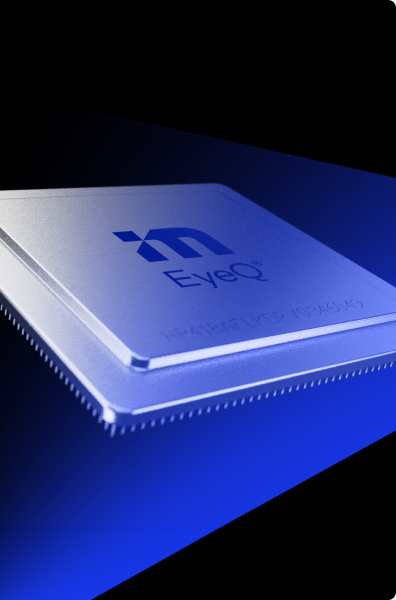THE BIG LEAP
From ADAS to AV and Back
When the company was founded, the category of advanced driver assistance systems (ADAS) was in its infancy and the industry was dominated by the belief that expensive radar sensors were necessary in order to perform the necessary functions, or at the very least two cameras (stereo vision) that utilize traditional triangulation methods to calculate range and velocity. Based on his pioneering academic research, Shashua proved that critical safety functions such as Automatic Emergency Braking (AEB) and basically all perception tasks could be achieved using a single camera (mono vision). The ability to combine those revolutionary algorithms with a custom-designed and highly efficient EyeQ™ SoC mounted on the windshield was a true game changer for the industry, making ADAS relevant for the mass market. From that point on, Mobileye established many industry firsts and pioneered many of the vision-based ADAS functions prevalent today.
After becoming a world leader in computer vision for ADAS, around 2013, Mobileye came to the understanding that the ADAS technology it had been developing made up some of the crucial building blocks needed to develop a fully autonomous car, and began pursuing this in earnest. It was at that time that Prof. Shai Shalev-Shwartz, a close friend, colleague and research partner of Shashua joined Mobileye in a full-time capacity. In 2019, Shalev-Shwartz became the CTO of Mobileye – a position he holds to this day.
Graduating from ADAS to AV did not only require additional sensors and more advanced algorithms; it also required solving the industry-wide challenges of regulating AV safety, creating HD maps for AVs at scale, and driving down the cost of the hardware needed for each vehicle – all areas where Mobileye is a leader in the industry by tackling the challenges of scale head on. In the area of defining safety for AVs, Shalev-Shwartz and Shashua co-authored a seminal research paper about a new formal model for defining what safety means in the context of making driving decisions. The model, called Responsibility-Sensitive-Safety (RSS), has gained momentum with industry and regulatory bodies for defining the assumptions, in a mathematical form, that drivers make in balancing safety and utility while providing formal guarantees against causing an accident. RSS also became the backbone of Mobileye’s “driving policy” by replacing “predictions” that classical robotics-inspired policy algorithms rely on – while consuming huge computational resources – with “intentions” that require a fraction of the computational capacity.
Additionally, Mobileye’s AV mapping technology – Road Experience Management™ – utilizes Mobileye’s computer vision expertise to create a highly compelling solution for cost effective and geographically scalable mapping. REM™ leverages the global crowd of Mobileye-equipped vehicles to collect relevant data from the road, and send it to the cloud at very low bandwidth, automatically creating a map of the world for AVs.
Since the acquisition by Intel, Mobileye has experienced vast growth. In March 2017, Mobileye had over 750 employees, whereas today there are over 2500 employees in a full-time capacity. Revenue as well went from just over $350 million at the end of 2016, to close to $1B at the end of 2020, and during the first nine months of 2021 ending September, the year-on-year revenue growth stood at 62%.
Today, the company offers a variety of autonomous mobility solutions all alongside its significant ADAS business. In fact, the ADAS business has significantly benefited from having R&D for autonomous driving under the same roof. Most notably, based on its computer vision expertise, Mobileye has built a fully autonomous vehicle which can drive on cameras alone. This 11-camera subsystem has now been productized into the ADAS realm, offering one of the world’s leading premium driver-assist solutions for a variety of hands-free driving functions: Mobileye SuperVision™. The first vehicle equipped with Mobileye SuperVision™ is already in production today with the Geely group. In this way, Mobileye has come full circle from a leader in the ADAS revolution, to leading the ADAS evolution to autonomous driving, offering a suite of mature solutions from basic driver-assist to premium driver assist, to fully autonomous, working toward safer and smarter mobility for more people each day.
To view Mobileye’s ISO 9001 certificate, please click here.









